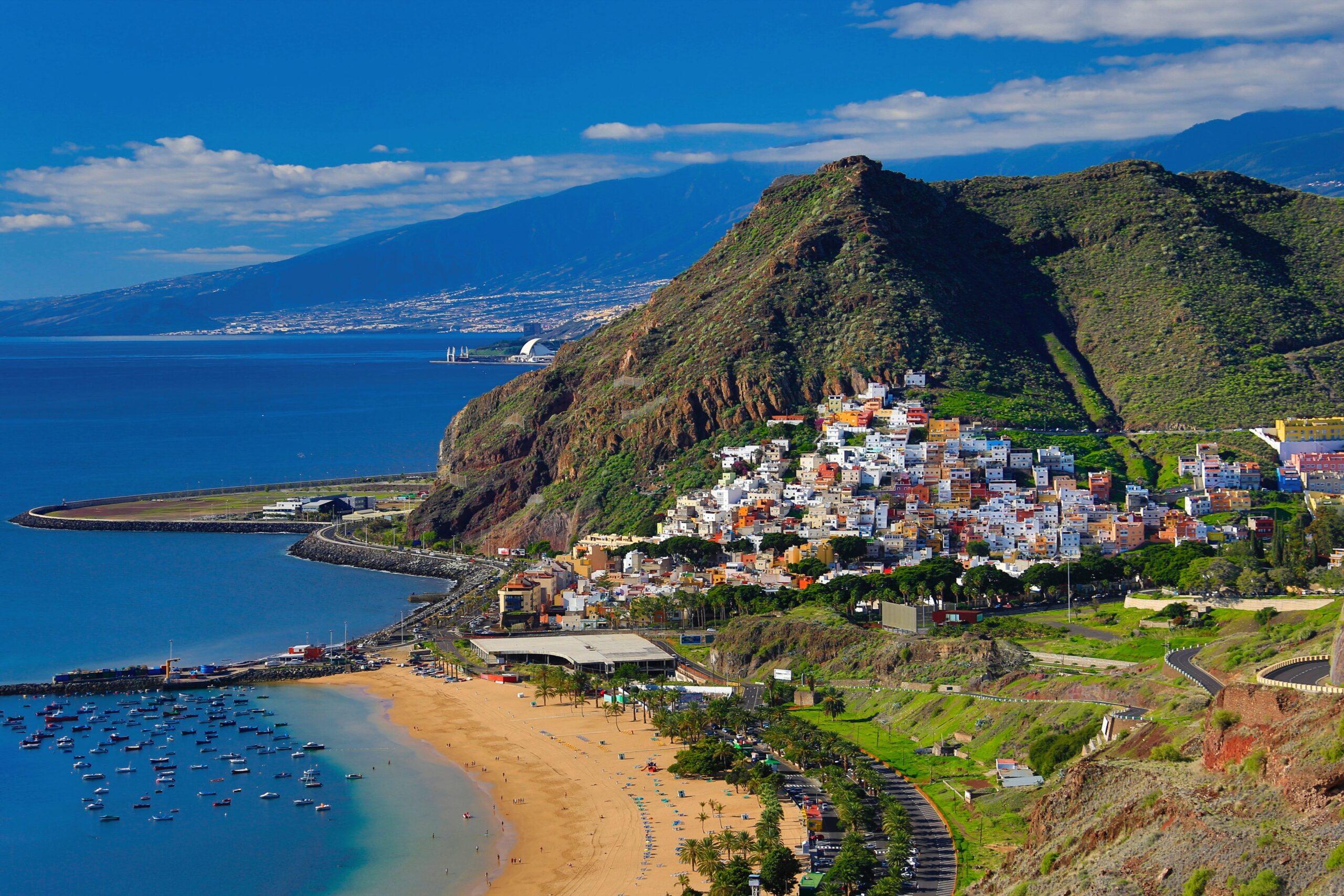
Tenerife is the largest of the Canary Islands, an archipelago located off the northwest coast of Africa. It has an area of approximately 2,034 square kilometers and a population of over 900,000 people. Tenerife is the most populous island of the Canary Islands, accounting for nearly half of the archipelago’s total population. The island is located approximately 300 kilometers west of the coast of Morocco and is geographically divided into two parts by the Anaga Mountains. The northern part of the island is more rugged and mountainous, while the southern part is flatter and more arid.
The island has a long history, with evidence of human settlement dating back over 2,000 years. The indigenous people of Tenerife were known as the Guanches, who were of North African origin and spoke a language called Silbo Gomero.
Tenerife was first visited by Europeans in 1493, when it was discovered by the Spanish navigator Alonso Fernández de Lugo. The island was subsequently colonized by the Spanish, who established a number of settlements and began exploiting its natural resources.
Tenerife played an important role in the early exploration of the Americas, serving as a stopping point for Spanish ships en route to the New World. Many of the ships that carried Columbus and other explorers on their voyages stopped at Tenerife to take on supplies and water.
In 1797, Tenerife was the site of a famous battle between the British and Spanish fleets, known as the Battle of Santa Cruz de Tenerife. The British forces were attempting to capture the city of Santa Cruz, but were repelled by a combination of Spanish fortifications and determined resistance from the local population.
Tenerife’s economy has traditionally been based on agriculture, with crops such as bananas, tomatoes, and potatoes being grown on the island. In recent years, however, tourism has become an increasingly important industry, with millions of visitors coming to the island each year to enjoy its warm climate, beaches, and natural beauty.
Mount Teide, located in the center of the island, is the highest peak in Spain and the third highest volcano in the world. It stands at 3,718 meters tall and is a popular destination for hikers and tourists. Mount Teide is one of the most iconic and recognizable landmarks on the island of Tenerife. It is a UNESCO World Heritage site and is considered to be one of the most important natural landmarks in Spain. The mountain is a stratovolcano that last erupted in 1909, and it is still considered to be an active volcano. Its distinctive conical shape and rugged terrain make it a popular destination for hikers and climbers, who come from all over the world to experience its unique beauty and challenge themselves on its slopes.
Tenerife is home to several important cultural festivals, including the Carnival of Santa Cruz de Tenerife, which is one of the largest carnivals in the world. The festival attracts visitors from all over the globe, who come to enjoy the parades, music, and dancing.
Tenerife has a rich cultural heritage, with numerous museums and art galleries showcasing the island’s history and artistic traditions. The Museum of Nature and Man is particularly notable, featuring exhibits on the island’s natural history and the Guanche culture.
The island is known for its traditional cuisine, which features a variety of seafood dishes, stews, and local cheeses. One of the most famous dishes is the “papas arrugadas,” or “wrinkled potatoes,” which are boiled in salt water and served with a spicy sauce called “mojo.”
Tenerife is home to several UNESCO World Heritage Sites, including the Teide National Park and the San Cristóbal de La Laguna historic center. These sites are recognized for their cultural and natural significance, and are popular destinations for tourists and locals alike.
Tenerife is a popular destination for astronomy enthusiasts, thanks to its clear skies and lack of light pollution. The island is home to several observatories, including the Teide Observatory, which is operated by the Instituto de Astrofísica de Canarias.
Tenerife is known for its beautiful beaches, with over 70 kilometers of coastline offering a variety of landscapes and activities. From sandy stretches to rocky coves, there is something for everyone on the island’s beaches.
The beaches in the south of the island are some of the most popular among visitors, thanks to their calm waters and abundance of amenities. Playa de las Americas is one of the most famous beaches in this region, with a lively atmosphere, soft sand, and crystal-clear waters. Other popular beaches in the south include Playa de la Arena, Los Cristianos, and Costa Adeje, all of which offer a variety of water sports and other activities.
The north of the island also has a wealth of beautiful beaches, each with its own unique charm. Playa de Bollullo, located in the town of La Orotava, is known for its black sand and wild, natural surroundings. Playa Jardín, located in Puerto de la Cruz, is a stunning beach with a tropical garden and an impressive backdrop of volcanic mountains. Other popular beaches in the north include Playa de El Socorro and Playa del Muelle.
The island has a mild and pleasant climate year-round, with temperatures rarely dropping below 15°C in winter and rarely exceeding 30°C in summer. This makes it an ideal destination for visitors looking to escape harsh winter weather or scorching summer heat. The climate is influenced by the trade winds, which keep the island cool and temperate throughout the year. The north of the island is generally cooler and more humid than the south, thanks to the influence of the prevailing winds and the island’s mountainous terrain. Visitors to Tenerife can expect plenty of sunshine and warm temperatures, even during the winter months. This makes it an ideal destination for outdoor activities such as hiking, cycling, and water sports, as well as for relaxing on the beach or by the pool.
Tenerife has a well-developed transportation network, with two airports, a ferry port, and an extensive system of roads and public transport. This makes it easy for visitors to explore the island and access its many attractions.
Tenerife is a popular destination for scuba diving, thanks to its clear waters and rich marine life. The island has several dive centers and schools offering courses and guided dives for all levels of experience.
The island has a vibrant nightlife scene, with a wide range of bars, clubs, and entertainment venues. From intimate jazz bars to large-scale nightclubs, there is something for everyone looking to party in Tenerife.
Tenerife is a popular destination for families, with numerous attractions and activities suitable for all ages. These include water parks, zoos, and theme parks, as well as hiking and outdoor activities in the island’s natural parks.
Tenerife has a rich musical tradition, with a number of local bands and musicians performing traditional and contemporary music. The island is also a popular venue for international music festivals, including the Arona Summer Festival and the Sunblast Festival.
The island has a diverse range of landscapes and ecosystems, ranging from volcanic mountains and forests to coastal plains and wetlands. This biodiversity has led to the creation of several protected natural areas, including the Anaga Rural Park and the Teno Rural Park.
Tenerife has a strong sporting culture, with a variety of activities available for visitors and locals alike. These include golf, tennis, cycling, and water sports such as surfing, windsurfing, and kiteboarding.
Tenerife has a well-established cultural scene, with numerous theaters, cinemas, and galleries showcasing local and international talent. The island also hosts several cultural events throughout the year, including the International Film Festival and the Classical Music Festival of the Canary Islands.
Tenerife has a rich history of craftsmanship, with local artisans producing a variety of traditional goods including pottery, textiles, and jewelry. These can be found in markets and shops throughout the island, offering visitors a chance to take home a unique and authentic souvenir.
Tenerife is home to several unique geological formations, including the Malpais de Güímar lava fields and the Masca Gorge. These natural wonders offer visitors a chance to explore the island’s volcanic history and geology.
Tenerife is a popular destination for digital nomads, thanks to its high-speed internet and affordable cost of living. The island has several co-working spaces and cafes offering free wifi, making it an ideal destination for remote workers looking to combine work and travel.









